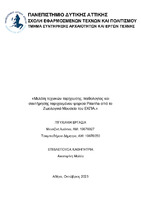| dc.contributor.advisor | Malea, Ekaterini | |
| dc.contributor.author | Μεντζίνη, Ιωάννα | |
| dc.contributor.author | Τσαμποδήμου, Δήμητρα | |
| dc.date.accessioned | 2024-01-05T10:50:04Z | |
| dc.date.available | 2024-01-05T10:50:04Z | |
| dc.date.issued | 2023-10 | |
| dc.identifier.uri | https://polynoe.lib.uniwa.gr/xmlui/handle/11400/5785 | |
| dc.identifier.uri | http://dx.doi.org/10.26265/polynoe-5622 | |
| dc.description.abstract | Η παρούσα πτυχιακή εργασία επικεντρώνεται στην μελέτη τεχνικών ταρίχευσης, παθολογίας και συντήρησης ενός μουμιοποιημένου ψαριού Piranha που ανήκει στο Ζωολογικό Μουσείο του ΕΚΠΑ. Στο πρώτο μέρος της εργασίας παρουσιάζεται βιβλιογραφική έρευνα σχετικά με τα μουσεία φυσικής ιστορίας καθώς και ειδικότερα για το Μουσείο Ζωολογίας του Πανεπιστημίου Αθηνών. Ακολουθεί παρουσίαση και ανάλυση των τριών μεθόδων κατεργασίας: ταρίχευση, μουμιοποίηση και διατήρηση σε υγρά μέσα. Έπειτα καταγράφονται οι κίνδυνοι και οι φθορές των ταριχευμένων σπονδυλόζωων, καθώς και οι κίνδυνοι που μπορεί να επιφέρουν στον άνθρωπο ως συνέπεια της χρήσης τοξικών υλικών. Τέλος, θίγονται ζητήματα προληπτικής και επεμβατικής συντήρησης καθώς και θέματα ηθικής σχετικά με τα αντικείμενα φυσικής ιστορίας. Στο δεύτερο μέρος της εργασίας τίθεται το ερώτημα των μεθόδων διατήρησης που χρησιμοποιήθηκαν. Ώστε να απαντηθεί το κύριο ερώτημα, πραγματοποιήθηκε μια σειρά αναλύσεων. Αρχικά πραγματοποιήθηκε ακτινογραφία ακτίνων Χ όπου διαπιστώθηκε η ύπαρξη της σκελετικής δομής και των μυών, κάτι που οδήγησε στην αμφισβήτηση της ταρίχευσης ως της παρούσας μεθόδου διατήρησης. Οι αναλύσεις συνεχίστηκαν με φασματοσκοπία υπερύθρων μετασχηματισμού Fourier, με ηλεκτρονικό μικροσκόπιο σάρωσης και με δοκιμές καθαρισμού. Τα αποτελέσματα των παραπάνω αναλύσεων οδήγησαν στο συμπέρασμα ότι η μέθοδος διατήρησης που υπέστη το αντικείμενο, δεν είναι η ταρίχευση αλλά πρόκειται για μέθοδο μουμιοποίησης. Τέλος, γίνεται πρόταση τρόπου έκθεσης του αντικειμένου σε μουσειακό χώρο. | el |
| dc.format.extent | 126 | el |
| dc.language.iso | el | el |
| dc.publisher | Πανεπιστήμιο Δυτικής Αττικής | el |
| dc.rights | Αναφορά Δημιουργού - Μη Εμπορική Χρήση - Παρόμοια Διανομή 4.0 Διεθνές | * |
| dc.rights | Attribution-NonCommercial-NoDerivatives 4.0 Διεθνές | * |
| dc.rights.uri | http://creativecommons.org/licenses/by-nc-nd/4.0/ | * |
| dc.subject | Ταρίχευση | el |
| dc.subject | Μουμιοποίηση | el |
| dc.subject | Μουσεία Ζωολογίας | el |
| dc.subject | Piranha | el |
| dc.subject | Διατήρηση σε υγρά μέσα | el |
| dc.subject | Ακτινογραφία | el |
| dc.subject | Φασματοσκοπία υπερύθρου μετασχηματισμού Fourier | el |
| dc.subject | FTIR | el |
| dc.subject | Ηλεκτρονικό μικροσκόπιο σάρωσης | el |
| dc.subject | SEM | el |
| dc.subject | Προληπτική και επεμβατική συντήρηση | el |
| dc.subject | Κώδικας δεοντολογίας | el |
| dc.subject | Δεοντολογία συντήρησης | el |
| dc.subject | Taxidermy | el |
| dc.subject | Mummification | el |
| dc.subject | Zoology museums | el |
| dc.subject | Wet preservation | el |
| dc.subject | X-ray radiography | el |
| dc.subject | Fourier Transform Infared Spectroscopy | el |
| dc.subject | Scanning Electron Microscopy | el |
| dc.subject | Preventative and interventional conservation | el |
| dc.subject | Conservation ethics | el |
| dc.title | Μελέτη τεχνικών ταρίχευσης, παθολογίας και συντήρησης ταριχευμένου ψαριού Piranha από το Ζωολογικό Μουσείο του ΕΚΠΑ. | el |
| dc.title.alternative | Study of the taxidermy techniques, pathology and conservation of a taxidermied Piranha fish from the Zoological Museum of the National and Kapodistrian University of Athens. | el |
| dc.type | Πτυχιακή εργασία | el |
| dc.contributor.committee | Panagiaris, Georgios | |
| dc.contributor.committee | Boyatzis, Stamatis | |
| dc.contributor.faculty | Σχολή Εφαρμοσμένων Τεχνών & Πολιτισμού | el |
| dc.contributor.department | Τμήμα Συντήρησης Αρχαιοτήτων και Έργων Τέχνης | el |
| dc.description.abstracttranslated | The present thesis focuses on the study of the taxidermy techniques, pathology and conservation of an embalmed piranha fish that belongs to the collection of the Zoological Museum of the National and Kapodistrian University of Athens. The first part of the paper presents bibliographical research on natural history museums and particularly the Zoological Museum of the National and Kapodistrian University of Athens. Following, the three processing methods; taxidermy, mummification, and wet preservation are presented and analyzed. Then, the risks and damage of taxidermied vertebrate animals are documented, as well as the dangers they may pose to humans as a consequence of the use of toxic materials. Furthermore, issues are addressed on preventative and interventional conservation and moreover ethical issues surrounding natural history specimens. In the second part of the paper the question of the preservation methods used is being set. For the question to be answered, a series of analysis methods was performed. X-ray radiography was initially performed, where the skeletal and muscle structure were found to exist. This result led to the questioning of taxidermy as the method of use on this specimen. The analyzes continued with Fourier Transform Infrared Spectroscopy, with Scanning Electron Microscopy and cleaning tests. The results of the mentioned methods used, led to the conclusion that the preservation method that the specimen went through is in fact mummification and not taxidermy. Finally, a proposal is being made for the exhibition of the object in a museum setting. | el |


